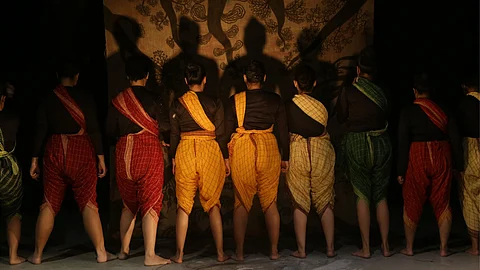
- HOMEGROWN WORLD
- #HGCREATORS
- #HGEXPLORE
- #HGVOICES
- #HGSHOP
- CAREERS
- ABOUT US
- CONTACT US

Theatre, as an art form, has been prevalent in Bengal since the 1770s. Its contemporary form began with the advent of the Indian freedom movement. Initially a form of private entertainment in the early 19th century, it later served as a significant tool of agitation propaganda against the British Raj’s occupation of India.
The advent of fast-paced mass communication mediums like television, and now the internet, have subdued the theatre culture, in terms of popularity in the entertainment sector. However, Kolkata, the nucleus of Bengali art and culture, still plays host to various theatre groups. There are several from both rural parts of West Bengal and urban Kolkata with the rural groups being influenced by jatras — the age-old regional Bengali Theatre.
The most popular Bengali theaters are the Academy of Fine Arts, Rabindra Sadan, Nahabat, Girish Manch, Minerva Theatre, and Tapan Theatre, which are all renowned for hosting plays, exploring socio-political awareness in Bengali society. Bengali theatre has earned a reputable name in the performing arts fraternity and has witnessed brilliant minds such as Utpal Dutta, Sisir Kumar Bhaduri, Ritwik Ghatak, and Girish Chandra Ghosh, to name a few. Today, we shall explore two theatre troupes from contemporary Kolkata, who are upholding traditions and staying true to their craft.
I. Samuho
Samuho is a queer and women-centric performing collective of people from all across the gender spectrum consisting of theatre practitioners, performers, actors, writers, scholars, painters, and musicians, based in Kolkata. Their primary works revolve around creating plays, researching gender and performance, and application of theatre practices to aid gender-marginalized people to explore the possibilities of their bodies. They prefer working in organic spaces like school fields, yards, and streets but also have experience in proscenium spaces. The group is three and a half years old now and their operative words are 'accessibility' and 'inclusivity', especially when it comes to theatre practice and participation of culturally, economically, and gender-marginalized people.
The troupe identifies itself as a physical theatre group. They often take famous texts such as Mahabharta, Manasamangal Kavya, and others and retell them from a contemporary queer, feminist perspective. Samuho and its members are heavily influenced by the works of theatre giants such as Badal Sircar and Habib Tanvir. The group’s modus operandi is also inspired by traditional theatre practices around India such as Yakshagana (Karnataka and Kerala), Kattaikkuttu (Tamil Nadu), and, Terukkuttu; a form of street theatre practiced in Tamil Nadu and parts of Sri Lanka. Samuho is currently involved in research work with Kattaikkuttu Sangam, a school studying and implementing traditional theatre practice.
We explored Samuho and its works through an interview with Titas Dutta, a member of Samuho since its inception, and a theatre practitioner for the last two decades. She shared with us the troupe’s deep reverence for jatra and its ability to connect with the rural audience. Samuho has often traveled to different parts of India to acquaint themselves with rural styles of theatre. In addition to ongoing research work, Samuho has a production lined up for 2023 with Indian playwright, Abhishek Majumdar. The troupe’s future plan is to create its own performance space in Birati, West Bengal, which is its base. “I have worked in many famous theatre groups over the years but no troupe provides a safer platform for performing artists than Samuho. I love working with so many creative women and queer people around me. One of our wishes is to stage a play in Bangladesh someday,” Titas said in the interview.
II. Takht
The group celebrates its inception when it performed its first show on August 24 2014. The idea behind its formation was to bring together enthusiastic dancers, with multidisciplinary backgrounds, to exercise their artistic vocabulary and create a new form of performance. Sangram Mukherjee, one of the primary choreographers and think tanks of the troupe since its inception said in an interview with us, “My journey with Takht has been exciting and exhausting. When your work is based on stepping away from the stringent methodology, it becomes doubly important to introspect what we deliver to the audience.”
The group has moved away from the traditional proscenium and black box spaces. To an outsider, their work may be viewed as an intersection of only dance and theatre but Sangram calls that distinction 'porous'. Takht looks at bodies as the sources of meaning and how lived experiences and narratives interact with texts. Portraying that and bringing it to the audience is their primary objective. Their inspirations are drawn from several origins outside the domain of dance and theatre.
Through their works, Takht seeks the articulate the lives that they witness. Their future work wants to focus on how we are bodily present after the global pandemic and to highlight the labor that goes into site-specific performances. The pandemic has shown thoroughly what physical absence entails. The group views theatre as a wonderful avenue of community-building with several facilities. Sangram also talked about how contemporary times in Kolkata not only lack infrastructural facilities but also about the government crackdown on artists and free thinking. In such trying times, solidarity between artists is of vital importance. When asked about Takht’s upcoming plans, Sangram said “The future plans are as porous and promiscuous as the dance form we practice. We are ready to adapt stories, inklings, words, or some feeling that will propel the need to perform. It could three weeks, a month, or even longer to produce that tangible output.”
You can find out more about Takht and its works here.
